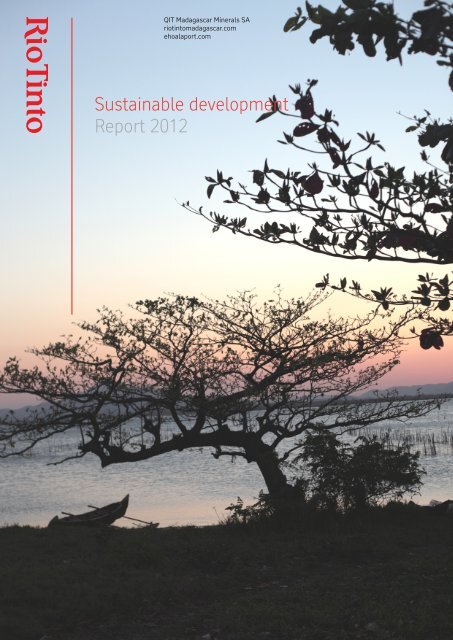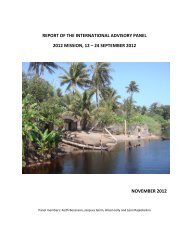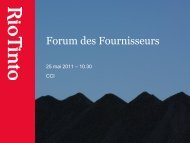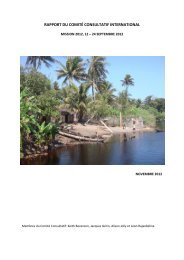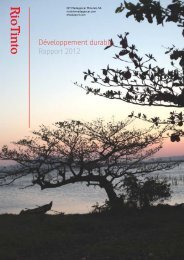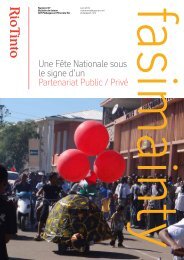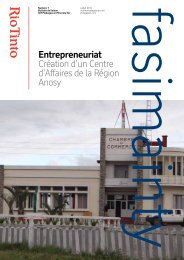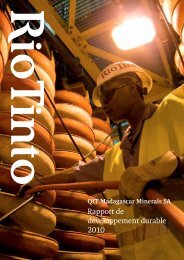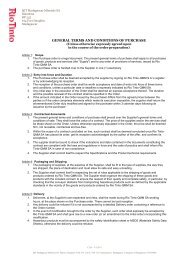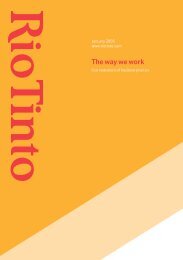Sustainable development Report 2012 - Rio Tinto - Qit Madagascar ...
Sustainable development Report 2012 - Rio Tinto - Qit Madagascar ...
Sustainable development Report 2012 - Rio Tinto - Qit Madagascar ...
You also want an ePaper? Increase the reach of your titles
YUMPU automatically turns print PDFs into web optimized ePapers that Google loves.
QIT <strong>Madagascar</strong> Minerals SA<br />
riotintomadagascar.com<br />
ehoalaport.com<br />
<strong>Sustainable</strong> <strong>development</strong><br />
<strong>Report</strong> <strong>2012</strong>
<strong>Sustainable</strong> <strong>development</strong> report <strong>2012</strong><br />
Summary<br />
QIT <strong>Madagascar</strong> Minerals 04<br />
Our approach to sustainable <strong>development</strong> 05<br />
Employees 06<br />
Health, accident prevention 06<br />
Communications and External Relations 09<br />
Community relations and sustainable <strong>development</strong> 10<br />
Environment 14<br />
Operational performance 16<br />
Economic performance 18<br />
2
<strong>Sustainable</strong> <strong>development</strong> report <strong>2012</strong><br />
Message from President<br />
It is with pleasure that I invite you to read the report of the <strong>2012</strong> calendar<br />
year. It provides details of the activities we have undertaken during the year<br />
and demonstrates our commitment to the different aspects of sustainable<br />
<strong>development</strong>. As an introduction, I would like to mention some facts illustrating<br />
these aspects and summarizing our last year performance.<br />
Accident prevention is fundamental in everything we do and we take nothing<br />
for granted. Even though our performance in the field within <strong>Rio</strong> <strong>Tinto</strong> Group<br />
features among the best, we find that we have not been able to reduce the<br />
incidence rate of all injury accidents according to our objectives for the year.<br />
Our Zero accident goal remains our most significant contribution to sustainable<br />
<strong>development</strong>.<br />
We still keep an upward trend in the production of ilmenite through our<br />
improvement in process control. We achieved a 24% increase over 2011<br />
production. We move towards the sustainable profitable growth and profitability.<br />
We are also proud of our external performance. The reports of the National Office for Environment (ONE) raised no<br />
major issue. With regard the biodiversity, we maintain our net positive impact objective (NPI). Within the community,<br />
we continue to promote the Public / Private Partnership (3P) approach in our community initiatives. This approach<br />
enables us to share resources and encourage stakeholder support. We also signed other strategic partnerships to<br />
implement <strong>development</strong> projects. We quote, among others, the World Bank, the PIC, UNICEF, the Pact <strong>Madagascar</strong><br />
and GIZ.<br />
However, we cannot further contribute to the <strong>development</strong> of the region if we do not become a profitable company in<br />
a sustainable way. This is a joint responsibility among stakeholders and we ask all involved to take action in their area<br />
of responsibility.<br />
That is how, in a principle of permanent improvement of our performance, we confirmed our strategic objectives:<br />
• In terms of accident prevention and health of employees, we will focus primarily on the analysis and<br />
management of critical risks to achieve our target for AIFR.<br />
• We need to continue to comply fully with all our legal obligations.<br />
• We shall continue the implementation of our transformation plan to ensure that QMM is profitable in a<br />
sustainable way. This transformation is based on operational excellence and permanent improvement by reducing<br />
our costs and increasing our efficiency. We need our employees to contributing to get involved in the success of our<br />
company and actually become our ambassadors in the community. The <strong>development</strong> of their talent remains our<br />
major goal.<br />
• Our community projects will be reoriented so that they are defined and implemented through a more<br />
effective partnership with stakeholders and they can truly meet the needs of clients and in return the company can<br />
have a return on investment.<br />
Our purpose is keeping our legal and social license to operate in a sustainable way. For this to happen, we will<br />
meet our legal obligations and our social commitments. But we also expect stakeholders, authorities, civil society,<br />
community, the respect of their respective obligations and commitments: compliance with applicable regulations,<br />
mutual respect through dialogue, vision over the long term by promoting sustainable projects.<br />
I hope that this report will provide educational information on our performance in sustainable <strong>development</strong>. I invite<br />
you to give us your feedback to help us developing.<br />
Ny Fanja Rakotomalala<br />
President - QIT <strong>Madagascar</strong> Minerals SA<br />
3
<strong>Sustainable</strong> <strong>development</strong> report <strong>2012</strong><br />
QIT <strong>Madagascar</strong> Minerals<br />
The 75 million tons of Fort Dauphin ilmenite deposit contain about 60% of titanium dioxide (Ti02). Mineral<br />
sands are spread over three areas totting up 6,000 ha. The ilmenite from <strong>Madagascar</strong> is sent to the QIT<br />
reduction plant in Canada to be turned into a slag content of more than 90% of Ti02. QMM also extracts<br />
zircon mixed with sillimanite from the deposit.<br />
Ilmenite is the most abundant source of titanium dioxide<br />
in the world. In its primary form or enriched form,<br />
ilmenite is used as the main raw material in the titanium<br />
pigment industry. Nearly 95% of the total consumption<br />
of titanium dioxide is intended for the production of<br />
white pigment. The production of titanium metal and<br />
other minor uses absorb the remaining 5% of titanium<br />
ore.<br />
The titanium dioxide can be found into finished product<br />
in our daily lives. It is mostly used in automotive<br />
construction, paint industry, building materials, and to a<br />
lesser extent in the production of plastic and paper.<br />
Zircon is mostly used in refractory foundries. It is<br />
also within the production of ceramics, sanitary ware,<br />
television screens and computer monitors. Refined,<br />
it is used in different electronic applications in the<br />
manufacture of jewelry and many industrial products.<br />
Emergent countries are the main consumers of ilmenite<br />
and zircon and represent 70-80% of the demand.<br />
QMM is 80% owned by <strong>Rio</strong> <strong>Tinto</strong> and 20% by the<br />
Malagasy government.<br />
4
<strong>Sustainable</strong> <strong>development</strong> report <strong>2012</strong><br />
Our approach to<br />
sustainable <strong>development</strong><br />
The responsibility is divided in this movement towards<br />
sustainable <strong>development</strong>. QMM is accountable to its<br />
host region with its legal obligations as well as its social<br />
commitments. But the government as well as the<br />
region are legally responsible for the social, economic<br />
and environmental <strong>development</strong> of the country and are<br />
accountable to the people of their performance in the<br />
field. It is up to the authorities to establish the rule of law<br />
in order to enable players to perform their activities in a<br />
climate conducive to business.<br />
The <strong>development</strong> is a shared concern. To reach<br />
concerted and integrated action and maximize the<br />
expected impacts, partnerships must be forged and<br />
exchanges required among stakeholders and recipients.<br />
Mutual respect is an integral principle of a viable<br />
partnership and constructive dialogue.<br />
In this partnership, a teamwork is required if we want to<br />
reach the same goal. The sense of belonging generated<br />
by the team spirit links each member to success or<br />
failure of the partner and encourages this one to act<br />
accordingly.<br />
Transparency goes along with integrity. <strong>Rio</strong> <strong>Tinto</strong> is<br />
ranked the second most transparent group in the world<br />
out of the 105 largest private groups. This rank defines<br />
us like a company with integrity and our organization<br />
has established procedures and needed guidelines to<br />
enforce integrity.<br />
Responsibility, Respect, Teamwork and Integrity<br />
are the four core values of <strong>Rio</strong> <strong>Tinto</strong>. These values<br />
underline our approach to sustainable <strong>development</strong><br />
and reaffirm our commitment to our social<br />
responsibility.<br />
This report presents such approach through four main<br />
areas:<br />
• Our employees ;<br />
• The community ;<br />
• The environment ; and<br />
• The economic and operational performance.<br />
5
<strong>Sustainable</strong> <strong>development</strong> report <strong>2012</strong><br />
Employees<br />
Profile of employees<br />
Our employees are key pillars of our business. Approximately<br />
1,320 people work for QMM and its contractors. 686 people are in<br />
permanent positions within the Company and the Port Ehoala. These<br />
permanent jobs are as follows :<br />
• 14% are women<br />
• 4% of expatriates<br />
• 76% malagasy employees were hired in Fort Dauphin.<br />
The comparison with the 2011 and earlier statistics show that<br />
we respect our hiring policy. This policy is intended not only to a<br />
gradual decrease in the number of expatriates (with the transfer<br />
of knowledge to the Malagasy employees), but also an increasing<br />
number of local employment (in collaboration with the Employment<br />
Service of Anosy).<br />
Recruitment<br />
We have taken on a principle of recruitment to meet our<br />
commitments in the field: maximize local hiring taking into account<br />
the skills required for the position to be filled. We worked with<br />
the Employment Service to identify and implement a transparent<br />
recruitment process that would ensure equal opportunities for all<br />
job seekers. The House of Employment in Anosy Region (MERA)<br />
was founded and the first treatments of all our jobs are performed<br />
by the staff of this institution. Reception of requests for jobs, sorting<br />
applications under the profile of the post, selection of candidates to<br />
be submitted to QMM.<br />
With equal skills, we set criteria which enable us to justify our<br />
selection between several applicants. In order of priority, these<br />
criteria are :<br />
1. An applicant residing within an impacted community by our<br />
construction and mining activities<br />
2. An capplicant born in or residing in Fort Dauphin or residing in Fort<br />
Dauphin for at least five-years, sufficient time for social inclusion<br />
in the environment<br />
Category Forecast Achievement<br />
Rate of achievement<br />
compared to forecast<br />
Distribution of<br />
achievement<br />
according to the<br />
category<br />
Professional technical 7 340 3 579 185% 41%<br />
Leadership 1 968 3 878 197% 12%<br />
Health, Safety, Environment and Quality<br />
(HSEQ)<br />
3. An applicant living or residing in Fort Dauphin for one to five years<br />
4. An applicant residing in the Anosy region less than a year<br />
5. A Malagasy applicant<br />
6. An expatriate<br />
In addition to the Employment Committee, a system for handling<br />
complaints about the recruitment process has been set up as a tag<br />
for any corruption or other violations of procedures.<br />
Training<br />
In <strong>2012</strong>, we completed 33,518 hours / Men training for our<br />
employees. These trainings are distributed as follows (see the table<br />
below). We focused on the <strong>development</strong> of technical skills with a<br />
priority for the training of mechanics technicians. We worked with a<br />
Canadian training center, not only to achieve the training, but also to<br />
identify the training needs of other sectors of operations.<br />
We have also provided 19,266 hours / men training in Health - Safety<br />
- Environment for employees of contractors.<br />
Integrated Talent Management System (SIGT)<br />
We start in <strong>2012</strong> our second year of operation of the integrated<br />
talent management system. This system is a global program for <strong>Rio</strong><br />
<strong>Tinto</strong>. It aims to support the management of individual employee<br />
performance to improve the overall performance of the Company.<br />
The cycle of talent management also helps identify potential<br />
successors for critical positions. In <strong>2012</strong>, we implemented a learning<br />
path for these employees. The objective is to quickly develop their<br />
skills, including those in leadership, and to enable them access to<br />
more responsibility.<br />
Development of local skills<br />
We started the second training program with the recruitment of<br />
young local graduates. The program will be implemented in 2013,<br />
aims to train technicians and will last two years. Our goal is to<br />
7 303 11 258 154% 34%<br />
Languages 4 620 2 268 49% 7%<br />
IT and RTBS 3 017 747 25% 2%<br />
Welcome and induction 2 780 1 788 64% 5%<br />
6<br />
27 028 33 518 124% 100%
<strong>Sustainable</strong> <strong>development</strong> report <strong>2012</strong><br />
contribute to the creation of a pool<br />
of local expertise.<br />
We call for training centers in<br />
nationwide. The theoretical training<br />
courses will be conducted in the<br />
training centers. The trainees will<br />
make then an internship at QMM<br />
to reinforce and implement the<br />
knowledge.<br />
« Young graduates »<br />
Programme<br />
The objectives of the « Young<br />
graduates » Programme are:<br />
• having competent and highly<br />
qualified human resources in the<br />
mining sector.<br />
• developing a pool of skills to meet<br />
current and future needs of our<br />
company.<br />
• identify local talents<br />
In <strong>2012</strong>, we recruited 7 graduates of<br />
which 4 were hired locally. For 2013,<br />
we will recruit 12 of which 75% will<br />
be hired locally.<br />
These young graduates will benefit<br />
from a structured training program<br />
over two years. They will occupy<br />
different positions in rotation during<br />
these two years. We assist them in<br />
their business knowledge, vision and<br />
values. Their annual <strong>development</strong><br />
plan is balanced between safety<br />
training, technical and practical<br />
training on site. Experienced<br />
mentors assist them during the<br />
second year to achieve their<br />
potentials<br />
We believe that :<br />
• new graduates play a significant<br />
part in our pool of professional<br />
talents,<br />
• talent management among new<br />
graduates is a key element of our<br />
strategy for human resources,<br />
• <strong>development</strong> of new graduates<br />
help us in building our business<br />
culture and instill it to our early<br />
career professionals,<br />
• by encouraging the <strong>development</strong><br />
of technical skills and business<br />
acumen of graduates we build the<br />
conditions of our success.<br />
If this process is well managed, it<br />
will provide a competitive advantage<br />
to QMM.<br />
Health, accident<br />
prevention<br />
Health and Industrial hygiene<br />
The main mission of the Health Service is to<br />
provide health and well-being of employees.<br />
16,000 medical consultations have been<br />
recorded for <strong>2012</strong> in the health center and<br />
2,900 medical visits were conducted by the<br />
occupational health care service (60% of<br />
pre-recruitment medical examinations and<br />
40% of periodic medical examinations).<br />
No case of occupational disease has<br />
been reported, and this since 2008. Some<br />
suspected cases of employees’ hearing<br />
loss have been detected, but the series of<br />
confirmatory tests conducted in accordance<br />
with appropriate monitoring protocol had<br />
finally disproved the initial suspicions. The<br />
latter, however, have encouraged us to<br />
consider improvements that might still be<br />
made in terms of hearing protection.<br />
Good synergy between the Industrial<br />
Hygiene and Occupational medical services<br />
led to monitor the daily exhibitions imposed<br />
on our employees, which could be a source<br />
of occupational disease. We were able to<br />
anticipate the suspected cases.<br />
For radiation, different procedures have<br />
been implemented to limit the exposure<br />
of employees: classification of radiation<br />
areas, staff training, work permits, etc...<br />
Different projects have been implemented<br />
to reduce sources of exposure such as<br />
provision of clean water separation process,<br />
dust extraction to the dry unit of the<br />
minerals separation plant, covering different<br />
equipment leaks, etc...<br />
Currently, the exposure of employees<br />
to radiation remains below the exposure<br />
limits established by the Malagasy and<br />
international laws. The Monitoring carried<br />
out by the national regulatory body (INSTN)<br />
is carried out separately for exposed workers<br />
and medical monitoring has moved from<br />
annual to bi-annual frequency with a view to<br />
reinforcement.<br />
Accident prevention<br />
We set out operational excellence in a Zero<br />
Accident culture. We focused on :<br />
• risk analysis before and during<br />
performance of tasks. A HSEQ Committee<br />
(Health and accident prevention<br />
Environment Quality) by sector was<br />
established to promote the effective<br />
involvement of employees in their own<br />
safety.<br />
• management of contractors<br />
• management of Significant Potential<br />
Incident (SPI) and the effective<br />
implementation of related actions to<br />
prevent the reproduction of the event.<br />
We also increased training courses and<br />
awareness of our employees and those<br />
of contractors to develop a culture of<br />
interdependent safety. The goal is to make<br />
any employee properly react to a dangerous<br />
situation. Significant challenges were<br />
identified so far but we still have long way to<br />
go reaching our ultimate goal of zero injury.<br />
LTI : Lost Time Injury<br />
MTC : Medical Treatment Case<br />
7
<strong>Sustainable</strong> <strong>development</strong> report <strong>2012</strong><br />
The number of injuries with medical treatment and lost time have increased compared to the previous year but still<br />
below 2008 reference state. A lack of coherence in the analysis of risks related to the task and work environment have<br />
been common contributing factors.<br />
Settings<br />
Reference condition<br />
Mining operations phase<br />
2008 2011 <strong>2012</strong><br />
Accident statistics(*) LTI 4 1 3<br />
Number of accidental events which<br />
required an investigation (**)<br />
MTC 12 5 6<br />
Total 16 6 9<br />
144 including 55<br />
near-misses<br />
190 of which 73 near<br />
misses (23 significant<br />
potential)<br />
210 including 138 near<br />
misses (28 significant<br />
potential)<br />
Preventive actions 195 322 279<br />
Number of non-compliances rectified<br />
at the following audits<br />
242 101 4<br />
Number of shifts lost due to injury 63 12 14<br />
Frequency rate of accidents with lost<br />
time (*)<br />
(*) Statistics in December 31, <strong>2012</strong><br />
0.06 0.06 0.17<br />
(**)A near miss is an unwanted event that caused no injury or damage but, in similar circumstances, might have resulted in serious accident.<br />
Emergency service<br />
The primary objective of the emergency service is to<br />
protect employees’ lives and property of the company<br />
in case of disaster. No serious injury or major material<br />
damage has been recorded at the end of all operations<br />
carried out by the team of the service.<br />
Of the 122 interventions, 38 (approximately 30%) are<br />
towards the people of Fort Dauphin: forest fires, fires in<br />
houses, drowning, etc.<br />
which the municipality had no way to fight so far. The<br />
members of the CPU, consisted of 15 military firefighters,<br />
have also benefited from a training program provided<br />
by members of the Avignon and Bordeaux (France)<br />
firefighters.<br />
We also materialized the project of establishing a Civil<br />
Protection Unit (CPU) in Fort Dauphin. This project is<br />
the result of a public / private partnership between the<br />
Malagasy Armed Forces, the Anosy region, the Urban<br />
Municipality of Fort Dauphin, the France Fort-Dauphin<br />
Firefighters Association and QMM. 2 fire engines and two<br />
containers of equipment to fight against the fire were<br />
given to the town for help to deal with fire risk against<br />
8
<strong>Sustainable</strong> <strong>development</strong> report <strong>2012</strong><br />
Communication and<br />
External relations<br />
Employees are among our key communication targets<br />
since they are our best ambassadors externally. We<br />
wanted to improve our internal communication tools by<br />
adapting needs and expectations of employees. But we<br />
have also reinforced our collection of comments as the<br />
flow of communication between management and an<br />
employee is effective.<br />
For external communication, we wanted to improve<br />
our image with the public. We reactivated our<br />
relationship with local and national media. We also<br />
promoted communications of proximity to increase the<br />
opportunities for a direct dialogue with the community.<br />
As part of our External Relations, our objectives for the<br />
year were :<br />
1. reinforcement the stakeholder engagement through<br />
the implementation of leadership initiatives and<br />
enhancing good governance. We must be able to<br />
count on this commitment in their respective areas<br />
of responsibility to be able to ensure our part in the<br />
<strong>development</strong> of the Region.<br />
2. contributing to the dynamics of regional <strong>development</strong><br />
through support of stakeholder engagement initiatives<br />
in public / private partnership.<br />
We have implemented several activities to achieve our<br />
objectives mainly :<br />
• An internal survey to assess our communication and<br />
to collect their suggestions<br />
• organization of periodic meetings with management<br />
and periodic diffusion of the status of our activities<br />
with employees<br />
• organization of press trips for the organs of presses<br />
could have direct contact with the people and see our<br />
work on land<br />
• organization of public events such as :<br />
--<br />
Fort Dauphin 2020 (exhibition, conference,<br />
competition) in Fort Dauphin and Antananarivo,<br />
--<br />
Kadaha (meeting with communities, exhibition,<br />
animation)<br />
--<br />
3P celebration (visit of achievements, conference,<br />
animation)<br />
• Signature and implementation of several public /<br />
private partnerships in areas such as civil protection,<br />
security, tourism partnerships.<br />
• Social mobilization in the public / private partnership<br />
for carrying out public interest work<br />
• Regular meetings with stakeholders at the national<br />
level<br />
Fort Dauphin in 2020, Kadaha, 3P social mobilization: as much major<br />
manifestaton which have enabled to have constructive face to face with our<br />
stakeholders<br />
9
<strong>Sustainable</strong> <strong>development</strong> report <strong>2012</strong><br />
Community Relations and<br />
<strong>Sustainable</strong> Development<br />
Maintain our operating social license<br />
Our goal is to create a shared, real value by aligning our business<br />
objectives and our expertise with the <strong>development</strong> priorities of local<br />
stakeholders and communities. We support the direct and active<br />
participation of our host communities with whom we have direct<br />
social contracts and from whom we take our social license.<br />
Our main commitments include our contribution to improving<br />
the livelihoods of our host communities and support their active<br />
participation in the economic activity generated by our operation. We<br />
continually apply our approach of working with communities :<br />
• in building and expanding our base of social, environmental and<br />
economic knowledge,<br />
• in building relationships and partnerships with those who bring the<br />
interests, skills and experience we do not have and<br />
• in implementing programs focused on the <strong>development</strong> and local<br />
economic investment.<br />
Use of land and resources by our host community<br />
Address the issue of community access to land and natural resources<br />
is one of the most important elements in maintaining our social<br />
license to operate. In doing so, we have reinforced and revitalized<br />
the DINA which is an exceptional Malagasy traditional social contract<br />
based on rights, responsibilities, benefits and mutually agreed rules.<br />
Since 2002, QMM supported the DINA as the basis of our work with<br />
our host community. In order to further promote partnerships with<br />
communities, as users of resources, and to ensure access to land<br />
and the joint management of biodiversity and natural resources<br />
within and outside of mining concessions Mandena, Sainte Luce<br />
and Petriky, we gave priority to integrated DINA to serve as a link<br />
between communities, livelihoods and our social and environmental<br />
obligations.<br />
To ensure that livelihoods being sustainable and reinforced and<br />
that social and environmental challenge are addressed, we focus<br />
on effective stakeholders’ engagement and dialogue as the key in<br />
building and maintaining trust with the community.<br />
Target our <strong>development</strong> efforts<br />
We strive to improve the way we work with communities, and the<br />
impact of our community investment, stressing the importance of<br />
data not only based on research but also complete. We also strive<br />
to develop, improve and exploit knowledge base, otherwise known<br />
as socio-economic base (including demographic trends, labour<br />
market, household behaviour and other social characteristics) of<br />
communities in which we interact. This allows a more informed<br />
strategy and decision-making according to the types of actors and<br />
given their resources, the logic of production and constraints.<br />
The activities implemented in <strong>2012</strong> within QMM in the Integrated<br />
Development Programme (IDP), an initiative launched in 2009,<br />
have promoted income generating activities to support sustainable<br />
livelihoods and include artisanal production, farming, fishing and<br />
honey production.<br />
Below are some figures illustrating the achievements:<br />
Handicraft<br />
• 285 recipient artisans<br />
• 24 154 200 Ar of total income generated<br />
• 23 253 items products<br />
Fishing<br />
• 128 fishermen received different support<br />
• 14 932 kg of fish production<br />
• 21 998 000 Ar of generated income<br />
Pig breeding<br />
• 130 pig farmers into 11 common initial pigsties<br />
• 520 piglets distributed to those pig farmers<br />
• 2 536 piglets produced in <strong>2012</strong><br />
• 1 439 sold cattles (piglet, fattened pig, reformed genitor)<br />
• 140 835 000 Ar of generated income<br />
Breeding of common carp and eel<br />
• 40 fish ponds built<br />
• 12 690 kg of fed fish<br />
• 2400 kg of sold eel<br />
• 205 recipients<br />
Activities implemented through the IDPs were evaluated as pilot<br />
community investments and are incorporated into a broader systemic<br />
approach related to initiatives of improved land and coastal areas<br />
management. Initiatives which build on the lessons learned are being<br />
diversified with a broader target population.<br />
In 2013, we will reinforce partnerships with key technical partners<br />
such as FAFAFI, Entreprise Manoa and SAHA to further improve the<br />
livelihoods and production capacity based on agriculture and fishing.<br />
This situation will allow us to address the food security of vulnerable<br />
populations as an alternative for users of resources affected by our<br />
operations. We will ensure access to credit through a partnership with<br />
the Mutual Fund of Mandrare-Fivoy to create two new microfinance<br />
institutions in the municipalities of Mandromondromotra and<br />
Ampasy Nahampoana.<br />
10
<strong>Sustainable</strong> <strong>development</strong> report <strong>2012</strong><br />
Implementation of our good<br />
neighbour policy<br />
We recognize that strong partnerships<br />
remain the most effective way for us to<br />
offer our contributions. We are working on<br />
nine priority municipalities strengthening<br />
community services and infrastructure<br />
through public-private partnerships (3P).<br />
To improve the well-being of communities,<br />
and the current and future workforce, we<br />
reinforce a program approach in line with<br />
regional priorities in health. Through a<br />
partnership with the Health Service of the<br />
District (SSD), the Regional Directorate of<br />
Public Health (PRSP), UNICEF and ASOS, we<br />
support the provision of maternal and child<br />
health services, while addressing health<br />
issues such as HIV / AIDS, tuberculosis and<br />
malaria. It also includes collaboration with<br />
other partners, including WaterAid, which<br />
will provide the water and sanitation services<br />
in collaboration with PIC / World Bank<br />
programme.<br />
To build local capacity and improve the<br />
accessibility and quality of education, we<br />
support an education program that includes<br />
scholarships, literacy, civic education,<br />
extracurricular activities, and technical<br />
training and leadership. In <strong>2012</strong>, 178 young<br />
people participated in seven literacy centers,<br />
57% have received their Certificate of<br />
Primary Education (CEPE) and incorporated<br />
a secondary school. Tutoring classes are<br />
reinforced throughout the school year to<br />
provide additional support to high school<br />
students in the preparation of national<br />
examinations. We also contributed to the<br />
construction of dormitories, canteens,<br />
classrooms and sports facilities within our<br />
priority municipalities.<br />
In 2013, we significantly expand our<br />
complementary scholarship, tutoring<br />
and mentoring programme. Through a<br />
partnership with Pact <strong>Madagascar</strong>, the<br />
scholarship programme of <strong>Rio</strong> <strong>Tinto</strong> for<br />
Education (RISE) will deliver more than<br />
1,300 primary, secondary and university<br />
scholarships based on academic merit and<br />
income.<br />
Lessons learned during the implementation of the activities of PDI will be applied to a wider and<br />
more targeted population<br />
11
<strong>Sustainable</strong> <strong>development</strong> report <strong>2012</strong><br />
Supporting a strong regional economy<br />
Our goal is not only to develop operational skills in the local recruitment, training, career <strong>development</strong> and the local<br />
supply chain, but also to ensure that the Community is actively involved in economic activity created by QMM. Below<br />
the evolution of our local purchases.<br />
Local purchases (USD) 2009 2010 2011 <strong>2012</strong><br />
Purchases of services 954 966 5 088 222 6 644 151 7 148 594<br />
Purchases of goods 5 163 862 1 059 314 999 134 774 820<br />
Total 6 118 828 6 147 537 7 643 285 7 921 414<br />
To promote entrepreneurial <strong>development</strong>, QMM, in collaboration with the PIC / World Bank programme and the recent<br />
created Anosy Regional Affairs Centre (CARA) provides training and support to build competent and qualified local<br />
businesses.<br />
The tables below summarize the main achievements of CARA in the field of entrepreneurship:<br />
Support for entrepreneurship<br />
Types 2011 <strong>2012</strong><br />
Company 28 48<br />
Individual company 150 288<br />
Total 278 335<br />
Trainings on entrepreneurship<br />
Modules issued<br />
Ketrika sy Karoka (Entrepreneurial culture<br />
and business plan)<br />
Targets<br />
Number of<br />
participants<br />
Concourents 175<br />
Entrepreneurial culture Individual 307<br />
Marketing Individual 224<br />
Simplified management Individual 215<br />
Business plan New entrepreneurs 188<br />
Entrepreneurship (Editing CV and Young job seekers 89<br />
Covering letter )<br />
Cooking<br />
Restaurant owner/ 70<br />
hotelier<br />
Tour Guiding Technique Guides 40<br />
Total 1308<br />
208 certificates were<br />
awarded to companies that<br />
have successfully completed<br />
the series of free Business<br />
Edge training.<br />
The ceremony was attended<br />
by the President of the<br />
Chamber of Commerce and<br />
Industry of Fort Dauphin.<br />
12
<strong>Sustainable</strong> <strong>development</strong> report <strong>2012</strong><br />
In terms of employment and micro-business creation,<br />
<strong>2012</strong> major achievements focused mainly on:<br />
• Support for the improvement of a favorable investment<br />
and business <strong>development</strong> climate. The promotion of<br />
“Ketrika sy Karoka Project” or project contest aiming at<br />
creating an entrepreneurial culture:<br />
--<br />
489 project leaders<br />
--<br />
300 files selected<br />
--<br />
239 project leaders achieved training<br />
--<br />
170 project leaders favorable for final interview<br />
This activity was conducted in cooperation with the<br />
CRD, PIC, EDBM, Port Ehoala, and other partners<br />
• Supporting the implementation of vocational training<br />
“Business Edge”<br />
The expected impacts of these trainings are mainly the<br />
availability of effective tools in order to:<br />
• Income increase<br />
• Mastering activities<br />
• Support business creation<br />
• Force position in seeking jobs<br />
• Best managerial effeciency<br />
To address employability and strengthen specific<br />
skills, we support HIMO initiatives in order to improve<br />
infrastructure. The projects include the rehabilitation<br />
roads and beautification of the city in diverse sites Fort<br />
Dauphin.<br />
In 2013, QMM and GIZ are launching a strategic<br />
alliance in order to promote business and value chain<br />
<strong>development</strong> for the poor in the district of Fort-Dauphin.<br />
Training Modules<br />
Number of participants<br />
• Business plan<br />
47<br />
• Control your Costs<br />
55<br />
• Plan your Budgets<br />
56<br />
• Effective team leadership<br />
84<br />
• Motivate your team<br />
15<br />
• Improve your customer service<br />
51<br />
• Find solutions to your problems<br />
57<br />
• Communicate effeciently<br />
63<br />
Total 428<br />
Distribution of participants by profile and training topic<br />
Themes<br />
Profiles<br />
Leading<br />
effectively<br />
Motivate<br />
your teams<br />
Improve your<br />
customer<br />
service<br />
Communicate<br />
efficiently<br />
Solve your<br />
problems<br />
Leaders 17 08 11 06 15<br />
Employees 63 07 37 57 36<br />
Unemployed 04 - 03 - 06<br />
Total 84 15 51 63 57<br />
13
<strong>Sustainable</strong> <strong>development</strong> report <strong>2012</strong><br />
Environment<br />
Bird Watching days and<br />
exhibition during the<br />
World Environment<br />
Day has interested the<br />
people of Fort Dauphin.<br />
• We also opted for an exhibition to<br />
celebrate the World Environment<br />
Day on the theme “Green Economy”.<br />
Simultaneously, we held conferences<br />
during which we demonstrated the<br />
involvement of QMM in preserving the<br />
environment.<br />
• Finally, we chose a new strategy to raise<br />
awareness on the protection of frogs<br />
during the event “Save the Frog Day.”<br />
We got the contribution of the students<br />
participating in previous sensitization<br />
and we asked them to use the knowledge<br />
acquired to raise awareness and sensitize<br />
their neighbours. The best performances<br />
were awarded.<br />
Rehabilitation<br />
We have created 4 ha of Mahampy swamps<br />
on Mandena site. Our attempts to create<br />
artificial Mahampy marshes have all been<br />
successful and these 4ha follow other<br />
similar work.<br />
We have reforested 70 hectares on Mandena<br />
site. This reforestation is also within the<br />
framework of a comprehensive prevention<br />
strategy against dust generation on the site.<br />
Finally, we supported the Urban Municipality<br />
of Taolagnaro to stabilize the slope of the<br />
edge of the town streets.<br />
14<br />
Our three main objectives for <strong>2012</strong> are:<br />
• Continued work on of rehabilitation on Mandena deposit<br />
• The implementation of the Action Plan on Biodiversity<br />
• Updating of the Dina for management of land, water and marine<br />
natural resources and mineral deposits and around the Port<br />
d’Ehoala<br />
Biodiversity<br />
We have multiplied our event-advocacy for the protection of<br />
biodiversity and the environment. Our favorite targets were students<br />
because the preservation of biodiversity richness depends on their<br />
commitment and environmental quality of the region. We also<br />
have special exhibits that allowed us to reach a large portion of the<br />
population of Fort Dauphin.<br />
Events<br />
• We organized the Birdwatching Event in partnership with the<br />
Environmental Platform of Anosy. We have benefitted participants<br />
a day of observation at Mandena as well as an exhibition on the<br />
theme of water fowl. It was an opportunity for us to let them know<br />
the species that may be hunted and should be protected. The 1000<br />
participants were mostly students in secondary education, but Fort<br />
Dauphin population was also heavily involved in the events.<br />
• During a week, we also organized in our halls, an exhibition on<br />
the occasion of the International Day of Biodiversity. We got our<br />
visitors familiar with biodiversity on our sites and the surroundings.<br />
They have also benefited from all the documentation available to<br />
them.<br />
Environmental monitoring<br />
We undertook the monitoring and<br />
assessment of the biological quality of<br />
Mandena, Ambato Antsinanana and Petriky<br />
Protected Areas and to determine the state<br />
of degradation of coastal forests in our<br />
avoidance zones and offsets.<br />
We also keep track of the 11 biological<br />
indicators stipulated in our set of<br />
specifications (ESMP). This monitoring<br />
allowed us to assess the impacts of the<br />
mine on biodiversity and implement<br />
corresponding measures required.<br />
Biodiversity Offsets Programme<br />
Under the Net Positive Impact on<br />
biodiversity, we launched the Biodiversity<br />
Offset Program. The objective is to ensure<br />
that any residual potential impact being<br />
eliminated through a compensation system<br />
similar (Like for like or better). Three <strong>Rio</strong><br />
<strong>Tinto</strong> offsets sites were selected to be part of<br />
the programme:<br />
• Littoral forest of Sainte Luce (Fort<br />
Dauphin) managed by QMM : 498 hectares<br />
• Coastal forest of Mahabo (Vangaindrano)<br />
managed by Missouri Botanical Garden :<br />
1565 hectares<br />
• Tsitongambarika III dense forest of low<br />
altitude (Ivohibe) : about 4000 hectares
<strong>Sustainable</strong> <strong>development</strong> report <strong>2012</strong><br />
Management of these sites will be included in the integrated landscape management<br />
program. A base of 4 million has been engaged by <strong>Rio</strong> <strong>Tinto</strong> for the next three years.<br />
Industrial environment industriel<br />
<strong>Sustainable</strong> management of domestic waste<br />
Responsible management of waste is one of our priorities. The Urban Municipality of Fort<br />
Dauphin and QMM and the PIC project developed in the framework of the Public / Private<br />
Partnership, a waste management project in Fort Dauphin. The town of Fort Dauphin,<br />
supported by PIC will ensure the management chain garbage collection. QMM will contribute<br />
to the establishment of a public landfill that meets international standards.<br />
ISO 14001 Certification<br />
DNV International audit firm has confirmed our certifications among which the ISO 14001<br />
environmental certification. This certification we achieved in 2010 identifies us as a company<br />
whose activities respect the environment and communities.<br />
Water management<br />
The establishment of a closed water use process system has allowed us to decrease by<br />
more than 50% of the raw water sample from the natural drainage system. This positive<br />
improvement in respect of water resources has been possible thanks to the combined efforts<br />
of our technicians and experts in effective management of water resources.<br />
Key issues<br />
Our efforts remain focused on the involvement of stakeholders in the sustainable<br />
management and <strong>development</strong> of land and water resources.<br />
Our rehabilitation strategy must also take into account the context that will prevail after the<br />
mine closure<br />
Other highlights<br />
• We supported the election and<br />
installation of new officers of the<br />
Mandena Management Committee.<br />
• We participated in the <strong>development</strong><br />
of the national strategy for the<br />
conservation of Phelsuma (a gecko<br />
endemic to the region), which was<br />
held in Fort Dauphin. The workshop,<br />
which saw the participation of all<br />
stakeholders, led to a national action<br />
plan.<br />
• The Biodiversity Committee meeting<br />
was held in November. We were able<br />
to present our programs and strategies<br />
to the international experts committee<br />
and realigning in accordance with the<br />
recommendations made.<br />
• We worked with 15 students and<br />
researchers on topics related to<br />
conservation and biodiversity research.<br />
• We made a herpetological inventory of<br />
forest Mahabo.<br />
More than 200 women from rural towns and Ampasy Nahampoana Mandromondromotra have<br />
helped to create this swamp on the field of Mandena; according to them the quality of mahampy they<br />
have collected is really excellent<br />
Meeting of Biodiversity Committee in November<br />
15
<strong>Sustainable</strong> <strong>development</strong> report <strong>2012</strong><br />
Operational performance<br />
Permanent improvement<br />
Permanent improvement is a concept applied within<br />
the <strong>Rio</strong> <strong>Tinto</strong> Group for several years. The goal is to<br />
continually increase productivity and efficiency in<br />
each business unit. The department dedicated to the<br />
coordination of permanent improvement projects was<br />
implemented at QMM in 2011.<br />
It had, at first, to analyze the practices and local culture<br />
to decide an approach that takes into account the<br />
maturity of QMM in relation to permanent improvement<br />
in the context of <strong>Rio</strong> <strong>Tinto</strong>.<br />
Traditionally, permanent improvements were mainly<br />
machinery and equipment of the Company. But this has<br />
had no lasting impact on employees. Today, the concept<br />
focuses on the way to work. This new way of working is<br />
the participation of the employee in the understanding<br />
and resolution of key issues.<br />
We have implemented a strategy based on employee<br />
involvement and therefore a change in practice and<br />
culture. We wanted to get employees:<br />
• working with a sense of priorities and<br />
• teamworking.<br />
To do this, we have identified the basic tools and<br />
practices applicable to suit the maturity of the<br />
organization. We used these tools in the implementation<br />
of priority projects in order to create added value:<br />
• The Project Charter, a document that indicates the<br />
roles of all stakeholders in the project<br />
• The Visual Flow Mapping that describes the methods<br />
of current work identifies the risks and problems that<br />
may arise and the resources used<br />
• The RASCI that identifies the level of responsibility of<br />
the team<br />
• The Key Performance Indicators that measure<br />
quantified improvements against targets<br />
• Other tools more permanent solutions to the problems<br />
visible (Fishbone, 5 Why)<br />
This new way of working has enabled us to provide an<br />
added value of $ 19.7 million against a target of $ 14.6<br />
for <strong>2012</strong>.<br />
Production<br />
The global titanium dioxide market has grown<br />
significantly with the urbanization of China. Although<br />
forecasts double the market in the next 20 years,<br />
past experiences show that it is also a market whose<br />
<strong>development</strong> is linked to changes in global economic<br />
activity.<br />
In <strong>2012</strong>, our production has improved by approximately<br />
24% compared to 2011. Our production scenario is<br />
determined by demand, whether for ilmenite or zirsill.<br />
16
<strong>Sustainable</strong> <strong>development</strong> report <strong>2012</strong><br />
17
<strong>Sustainable</strong> <strong>development</strong> report <strong>2012</strong><br />
Economic performances<br />
The Port d’Ehoala<br />
The main challenge for the Port Ehoala is to ensure the<br />
<strong>development</strong> of various business activities contributing<br />
to the city and Anosy Region, while ensuring priority<br />
and quality service for shipments of ilmenite. Despite<br />
the unfavorable political and social context, the results<br />
will continue to improve and this year exceeded targets.<br />
Some of our statistics are presented in the table below.<br />
Ehoala Park<br />
Ehoala Park is the economic <strong>development</strong> zone of<br />
440 hectares adjoining the port. The study of strategic<br />
environmental assessment is underway. The detailed<br />
area planning programme is also under study. We also<br />
undertake the preparation of the servicing of the first<br />
subdivisions representing an area of 20 hectares.<br />
We signed three agreements in principle for significant<br />
investments that will create jobs:<br />
• A social project (70 permanent jobs)<br />
• A project of industrial maintenance (35 permanent<br />
jobs)<br />
• A project a proposed relocation of mica and sisal<br />
products (80 permanent jobs)<br />
Andriambe career<br />
Managing the career Andriambe, who provided the<br />
boulders (granite) needed for the construction of<br />
the breakwater of the port and other infrastructure<br />
was transferred to Port Ehoala at the end of phase<br />
construction.<br />
In <strong>2012</strong>, the World Bank has funded through the PIC<br />
project construction and rehabilitation of three bridges<br />
on National Road 13 and the rehabilitation of the streets of Fort Dauphin. The<br />
Andriambe career assured supply granite of this work.<br />
Cruise tourism<br />
2009 2010 2011 <strong>2012</strong><br />
Containers (TEU 1 ) 2 037 5 179 4 642 6 393<br />
Passengers 0 1 800 5 886 6 034<br />
Fuel (m 3 ) 5500 12 330 16 717 18 388<br />
Ship calls 70 120 135 112<br />
Tonnage total port 136 706 351 618 524 968 677 663<br />
1<br />
Twenty foot Equivalent Unit. It is a unit of measuring containers. One TEU represents about<br />
30 m3<br />
Since its opening in 2009, the port welcomed 18 cruise ships, which represents<br />
13720 passengers. In three season’s cruises, the recipe exchange is around one<br />
million euros divided the restaurants, tour operators, guides, ships agents, car<br />
rental, taxi, exchange offices, artisans and other local traders.<br />
The “Committee Cruises’ organized with the leadership of the port is set up for<br />
preparations of call. The Regional Tourism Office, the Chamber of Commerce<br />
and Industry, tour operators and members of the private sector in the field of<br />
tourism undertake alongside Port d’Ehoala to accommodate cruise ships and<br />
generate a home quality. The aim is to retain the owners so they always put the<br />
Port d’Ehoala in their catalog. This preparatory work is the means of sustainable<br />
tourism <strong>development</strong> in Fort Dauphin.<br />
18
<strong>Sustainable</strong> <strong>development</strong> report <strong>2012</strong><br />
The Port d’Ehoala<br />
on all fronts<br />
Contributions to<br />
the economy<br />
Our main contributions to the Malagasy economy affect the taxes<br />
we pay to the Malagasy government. We also record our few assets<br />
11,000 jobs that our presence has generated as well as income<br />
generated by our contractors. Below are statistics on taxe for the year<br />
<strong>2012</strong>.<br />
The port does not exclude any field when it comes to<br />
play its role as an engine of <strong>development</strong>. Sensitive to<br />
social problems of its neighbours, it has made available<br />
to fishermen and residents a fire hydrant. Water is<br />
drained from the water pipeline QMM and Port Ehoala.<br />
This supply of water directly on the fishing is very<br />
popular with the community.<br />
Payroll taxes<br />
Mining royalties<br />
TFT et IBS of non resident<br />
companies<br />
Custom duties<br />
Other taxes<br />
$5,5 millions<br />
$4,5 millions<br />
$3,5 millions<br />
$2,4 millions<br />
$3,8 millions<br />
In the field of Malagasy and international musical<br />
culture, Port Ehoala initiated the coming Madajazzcar<br />
Festival in Fort Dauphin for the fourth consecutive year<br />
since the opening of the port in 2009.<br />
In sports, the port is sponsoring a youth football club<br />
and an Aikido club for members to engage in good<br />
conditions of work for the good of everyone.<br />
19
<strong>Rio</strong> <strong>Tinto</strong><br />
<strong>Rio</strong> <strong>Tinto</strong><br />
QIT <strong>Madagascar</strong> Minerals. QIT <strong>Madagascar</strong> Minerals<br />
Villa 3H – Lot II J 169<br />
Mandena<br />
Ivandry BP 225<br />
BP 4003<br />
614 Fort-Dauphin<br />
101 Antananarivo <strong>Madagascar</strong><br />
<strong>Madagascar</strong><br />
T +261 20 22 425 59 T +261 20 92 210 26


